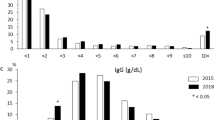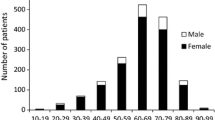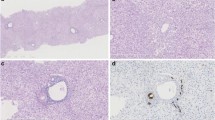Abstract
Background
Autoimmune hepatitis (AIH) is characterized by progressive inflammation and necrosis of hepatocytes and eventually leads to a variety of phenotypes, including acute liver dysfunction, chronic progressive liver disease, and fulminant hepatic failure. Although the precise mechanisms of AIH are unknown, environmental factors may trigger disease onset in genetically predisposed individuals. Patients with the recently established entity of AIH with acute presentation often display atypical clinical features that mimic those of acute hepatitis forms even though AIH is categorized as a chronic liver disease. The aim of this study was to identify the precise clinical features of AIH with acute presentation.
Methods
Eighty-six AIH patients with acute presentation were retrospectively enrolled from facilities across Japan and analyzed for clinical features, histopathological findings, and disease outcomes.
Results
Seventy-five patients were female and 11 were male. Patient age ranged from adolescent to over 80 years old, with a median age of 55 years. Median alanine transaminase (ALT) was 776 U/L and median immunoglobulin G (IgG) was 1671 mg/dL. There were no significant differences between genders in terms of ALT (P = 0.27) or IgG (P = 0.51). The number of patients without and with histopathological fibrosis was 29 and 57, respectively. The patients with fibrosis were significantly older than those without (P = 0.015), but no other differences in clinical or histopathological findings were observed. Moreover, antinuclear antibody (ANA)-positive (defined as × 40, N = 63) and -negative (N = 23) patients showed no significant differences in clinical or histopathological findings or disease outcomes. Twenty-five patients experienced disease relapse and two patients died during the study period. ALP ≥ 500 U/L [odds ratio (OR) 3.20; 95% confidence interval (CI) 1.12–9.10; P < 0.030] and GGT ≥ 200 U/L (OR 2.98; 95% CI 1.01–8.77; P = 0.047) were identified as independent risk factors of disease relapse.
Conclusions
AIH with acute presentation is a newly recognized disease entity for which diagnostic hallmarks, such as ALT, fibrosis, and ANA, are needed. Further investigation is also required on the mechanisms of this disorder. Clinicians should be mindful of disease relapse during patient care.



Similar content being viewed by others
References
Krawitt EL. Autoimmune hepatitis. N Engl J Med. 2006;354(1):54–66.
Mehendiratta V, Mitroo P, Bombonati A, et al. Serologic markers do not predict histologic severity or response to treatment in patients with autoimmune hepatitis. Clin Gastroenterol Hepatol. 2009;7(1):98–103.
Seki T, Kiyosawa K, Ota M, et al. Association of primary biliary cirrhosis with human leukocyte antigen DPB1*0501 in Japanese patients. Hepatology. 1993;18(1):73–8.
Yoshizawa K, Ota M, Katsuyama Y, et al. Genetic analysis of the HLA region of Japanese patients with type 1 autoimmune hepatitis. J Hepatol. 2005;42(4):578–84.
Yoshizawa K, Umemura T, Ota M. Genetic background of autoimmune hepatitis in Japan. J Gastroenterol. 2011;46(Suppl 1):42–7.
Umemura T, Ota M, Yoshizawa K, et al. Association of cytotoxic T-lymphocyte antigen 4 gene polymorphisms with type 1 autoimmune hepatitis in Japanese. Hepatol Res. 2008;38(7):689–95.
Yokosawa S, Yoshizawa K, Ota M, et al. A genomewide DNA microsatellite association study of Japanese patients with autoimmune hepatitis type 1. Hepatology. 2007;45(2):384–90.
Umemura T, Joshita S, Hamano H, et al. Association of autoimmune hepatitis with Src homology 2 adaptor protein 3 gene polymorphisms in Japanese patients. J Hum Genet. 2017;62(11):963–7.
de Boer YS, van Gerven NM, Zwiers A, et al. Genome-wide association study identifies variants associated with autoimmune hepatitis type 1. Gastroenterology. 2014;147(2):443–52.
van Gerven NM, Verwer BJ, Witte BI, et al. Epidemiology and clinical characteristics of autoimmune hepatitis in the Netherlands. Scand J Gastroenterol. 2014;49(10):1245–54.
Gronbaek L, Vilstrup H, Jepsen P. Autoimmune hepatitis in Denmark: incidence, prevalence, prognosis, and causes of death. A nationwide registry-based cohort study. J Hepatol. 2014;60(3):612–7.
Yoshizawa K, Joshita S, Matsumoto A, et al. Incidence and prevalence of autoimmune hepatitis in the Ueda area, Japan. Hepatol Res. 2016;46(9):878–83.
Takahashi H, Zeniya M. Acute presentation of autoimmune hepatitis: does it exist? A published work review. Hepatol Res. 2011;41(6):498–504.
Ohira H, Abe K, Takahashi A, et al. Autoimmune hepatitis: recent advances in the pathogenesis and new diagnostic guidelines in Japan. Intern Med. 2015;54(11):1323–8.
Lefkowitch JH, Apfelbaum TF, Weinberg L, et al. Acute liver biopsy lesions in early autoimmune (“lupoid”) chronic active hepatitis. Liver. 1984;4(6):379–86.
Takahashi A, Arinaga-Hino T, Ohira H, et al. Autoimmune hepatitis in Japan: trends in a nationwide survey. J Gastroenterol. 2017;52(5):631–40.
EASL Clinical Practice Guidelines. Autoimmune hepatitis. J Hepatol. 2015;63(4):971–1004.
Onji M, Zeniya M, Yamamoto K, et al. Autoimmune hepatitis: diagnosis and treatment guide in Japan, 2013. Hepatol Res. 2014;44(4):368–70.
Nguyen Canh H, Harada K, Ouchi H, et al. Acute presentation of autoimmune hepatitis: a multicentre study with detailed histological evaluation in a large cohort of patients. J Clin Pathol. 2017;70(11):961–9.
Alvarez F, Berg PA, Bianchi FB, et al. International Autoimmune Hepatitis Group Report: review of criteria for diagnosis of autoimmune hepatitis. J Hepatol. 1999;31(5):929–38.
Okano N, Yamamoto K, Sakaguchi K, et al. Clinicopathological features of acute-onset autoimmune hepatitis. Hepatol Res. 2003;25(3):263–70.
Miyake Y, Iwasaki Y, Kobashi H, et al. Autoimmune hepatitis with acute presentation in Japan. Dig Liver Dis. 2010;42(1):51–4.
Hennes EM, Zeniya M, Czaja AJ, et al. Simplified criteria for the diagnosis of autoimmune hepatitis. Hepatology. 2008;48(1):169–76.
Tiniakos DG, Brain JG, Bury YA. Role of histopathology in autoimmune hepatitis. Dig Dis. 2015;33(Suppl 2):53–64.
Muratori P, Granito A, Quarneti C, et al. Autoimmune hepatitis in Italy: the Bologna experience. J Hepatol. 2009;50(6):1210–8.
Yoshizawa K, Matsumoto A, Ichijo T, et al. Long-term outcome of Japanese patients with type 1 autoimmune hepatitis. Hepatology. 2012;56(2):668–76.
Sanchez-Urdazpal L, Czaja AJ, van Hoek B, et al. Prognostic features and role of liver transplantation in severe corticosteroid-treated autoimmune chronic active hepatitis. Hepatology. 1992;15(2):215–21.
Czaja AJ, Menon KV, Carpenter HA. Sustained remission after corticosteroid therapy for type 1 autoimmune hepatitis: a retrospective analysis. Hepatology. 2002;35(4):890–7.
Alla V, Abraham J, Siddiqui J, et al. Autoimmune hepatitis triggered by statins. J Clin Gastroenterol. 2006;40(8):757–61.
Acknowledgements
The authors thank Trevor Ralph for his English editorial assistance.
Funding
This study was conducted and supported by Health Labor Science Research Grants from Research on Measures for Intractable Diseases, the Intractable Hepato-Biliary Diseases Study Group in Japan.
Author information
Authors and Affiliations
Consortia
Corresponding author
Ethics declarations
Conflict of interest
The authors declare that they have nothing to disclose regarding funding from industries or other conflicts of interest with respect to this manuscript.
Rights and permissions
About this article
Cite this article
Joshita, S., Yoshizawa, K., Umemura, T. et al. Clinical features of autoimmune hepatitis with acute presentation: a Japanese nationwide survey. J Gastroenterol 53, 1079–1088 (2018). https://doi.org/10.1007/s00535-018-1444-4
Received:
Accepted:
Published:
Issue Date:
DOI: https://doi.org/10.1007/s00535-018-1444-4




